Ultherapy
Ultherapy ® is a non-surgical micro-focused ultrasound with visualisation (MFU-V) treatment that lift and sculpts the upper and lower face, neck and décolletage. Ultherapy uses precise micro-focused ultréé2asound with visualisation (MFU-V) energy to target the deep structural layers of the skin without disrupting the skin’s surface. After treatment, the body’s tissue repair process stimulates the production of new collagen and elastin creating a gradual lifting effect.
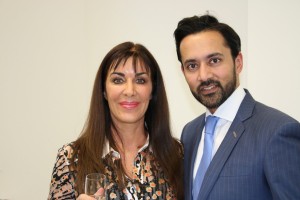
Jeanette Haynes & Dr. Tapen Patel at the PHI Clinic Harley St. London Ultherapy Practitioners Workshop
Ultherapy® tried and tested
Ultherapy has achieved one million treatments and has grown into a global leader in non-surgical aesthetics applications.
- Ultherapy is scientifically proven and stimulates new collagen and elastin
- Produces a lift that can last for more than a year
- Treatment takes from just 30 mins
- Minimal downtime after treatment
nbsp;
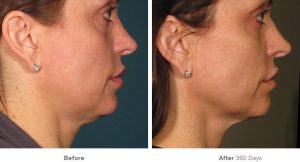
Ultherapy Full Face before and after photo
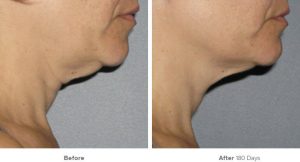
Ultherapy Chin & Neck before and after
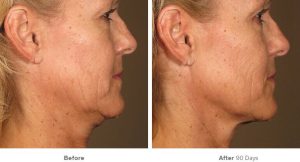
Ultherapy before and after of chin and neck area
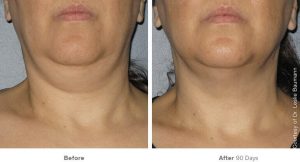
Chin area before and after photo
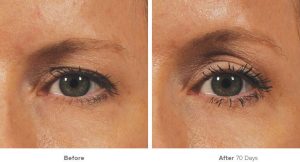
Ultherapy before and after eye treatment
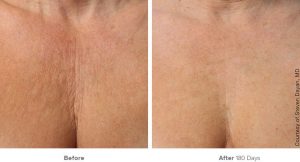
Ultherapy Chest before and after photo
FREQUENTLY ASKED QUESTIONS
How does Ultherapy work?
Ultherapy is a non-surgical micro-focused ultrasound with visualisation (MFU-V) treatment that stimulates the production of new collagen and elastin deep within the skin. Ultherapy uses precise micro-focused ultrasound with visualisation (MFU-V) energy to target the deep structural layers of the skin without disrupting the skin’s surface. After treatment the body’s tissue repair process stimulates the production of new collagen and elastin creating a gradual lifting effect.
What are collagen and elastin?
These are both important building blocks within our skin. Collagen is a protein that is abundant in our skin and is important in providing strength and stability. It is produced by special cells (called fibroblast) but over time our skin loses some of its collagen, contributing to skin laxity and sagging. Elastin is a highly elastic protein in skin and allows many tissues in the body to resume their shape after stretching or contracting. Elastin helps skin to return to its original position when it is poked or pinched. Again, as we age, our skin loses some elastin which also contributes to sagging and laxity. Since our faces are constantly subjected to movement and pressure (when we smile, sleep, talk, shout, cry, laugh or sing) the loss of elastin and collagen really can take its toll.
How long does a treatment take?
The length of the treatment will depend on the area being treated and your individual treatment plan. A face and neck procedure takes 60-90 minutes, while a chest treatment takes approximately 30 mins.
Will I need to take time off?
After an Ultherapy procedure, you can resume your usual lifestyle and activities immediately without having to follow any special post-treatment measures.
When will I see results? How long will they last?
You may see some initial lift, but the ultimate results will take place over 2-3 months, as the growth of new collagen and elastin replaces old tissue targeted by the treatment. A single Ultherapy treatment can give a lasting effect for over a year in some people and your practitioner will advise you on the likely outcomes for you.
How many Ultherapy treatments will I need?
Most patients need one treatment. However based on the degree of skin laxity, the biological response to micro focused ultrasound with visualisation (MFU-V) energy and the individual’s collagen building process, some patients benefit from additional treatments. Because skin continues to age, future touch-up treatments can help patient keep pace with the body’s natural ageing process.
Am I a candidate?
As a result of the natural ageing process our skin becomes less elastic. A good Ultherapy Candidate has mild to moderate skin laxity where the skin begins to look less firm or tight. Examples include a lowered brow, loose skin on the neck, sagging under the chin, and lines or wrinkles on the chest. Ultherapy results in a gradual lift, leaving patients looking refreshed. However Ultherapy will not produce results as drastic as a surgical facelift. Ultherapy is a great alternative, however, especially for those not ready for surgery or patients looking to extend the effects of cosmetic surgery.
Does Ultherapy replace the need for surgery (a facelift)
While Ultherapy does not duplicate the results of a facelift, it may be used before, or as an alternative to surgery, and after surgery to maintain the effects. Unlike surgery, it also has the added benefit of allowing you to resume your usual lifestyle and activities immediately.
How does Ultherapy differ from laser treatments?
Ultherapy uses micro-focused ultrasound with visualisation (MFU-V) energy to stimulate collagen production in the skin’s foundation, resulting in a clinically significant lift of tissue over 2 – 3 months. Lasers rely on light energy, which typically only treat superficial skin (around 1mm in depth) and are not FDA-cleared or CE Mark approved to lift skin. Lasers also work through the surface of the skin, often resulting in downtime after a procedure. Ultherapy’s micro-focused ultrasound with visualisation (MFU-V) energy bypasses the surface of the skin (going to depths betwee 1.5mm and 4.5mm) which means minimal downtime is usual required after the treatment. Since the two technologies often treat different types of skin issues, they can be compatible. As we have all of the most modern skin technologies here at the Body Benefits Aesthetic Clinic, we will advise you what is best for you.
How well is Ultherapy tolerated?
The Ultherapy procedure has been used in over 1,000,000 treatments worldwide. Every Ultherapy Practitioner receives extensive procedural training and tools so you can feel confident when choosing Body Benefits Medical Aesthetic Clinic to perform your procedure. Ultherapy is the only micro-focused ultrasound with visualisation (MFU-V) technology that has been reviewed and cleared by the US Food & Drug Administration, and CE mark certified in the EU, the bodies responsible for regulating medial devices.
Are there any side effects?
The redness should disappear within a few hours. Some patients experience slight swelling, tingling or tenderness to the touch, but these are temporary in nature. Other, less common post procedural effects may include temporary bruising or numbness on small areas of skin. As with any aesthetic medical procedure, there is the possibility for other side effects, which your practitioner will review with you.
What does the treatment feel like?
There may be some momentary discomfort (which varies from person to person), but the sensation only lasts while micro-focused ultrasound with visualisation MFU-V) energy is being delivered. At Body Benefits Medical Aesthetic Clinic, we will advise you on how to manage the discomfort in the way that is best for you.
Does Ultherapy hurt?
In order for Ultherapy to work, it has to heat the deep layers of the skin. Everybody will have different sensitivities to this heat and our practitioner will advise you on how best to manage any discomfort.
 Medical Skincare & Laser Clinic
Medical Skincare & Laser Clinic